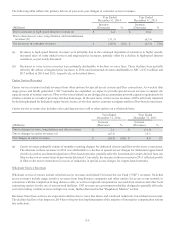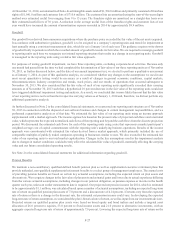Windstream 2014 Annual Report Download - page 133
Download and view the complete annual report
Please find page 133 of the 2014 Windstream annual report below. You can navigate through the pages in the report by either clicking on the pages listed below, or by using the keyword search tool below to find specific information within the annual report.
F-17
As part of the Order’s reform of intercarrier compensation, the FCC established two recovery mechanisms that mitigate the revenue
reductions resulting from the reduction and ultimate elimination of terminating access rates. First, the FCC established the ARC,
a fee which may be assessed to some of our retail customers. Second, the ARM is a form of additional federal universal service
support designed to allow carriers to recover some of the revenue reductions that cannot be recovered through assessment of the
ARC. Carriers are required to use ARM support to build and operate broadband networks in areas substantially unserved by an
unsubsidized competitor offering fixed voice and broadband service. Our ARM support is expected to decreased incrementally
from $52.3 million in 2014 to an estimated $12.3 million in 2017, with a portion of the decrease offset by future increases in ARC
revenues. Absent a change by the FCC to its current rules, the ARM will phase out annually in one-third increments, beginning
in July 2017, and will be eliminated completely as of July 2019.
On April 25, 2012, the FCC decided that originating access rates for intrastate long distance traffic exchanged between an Internet-
protocol network and the traditional telecommunications network should be subject to default rates equal to interstate originating
access rates beginning on July 1, 2014. The FCC refused at that time to adopt a mechanism that would allow companies to recover
the loss of originating access revenues resulting from the change. Our court challenge to this ruling was rejected in May 2014. We
continue to assess the impacts of the FCC’s intercarrier compensation reform on our wholesale business activities.
Set forth below is a summary of intercarrier compensation revenue and federal universal service support, included in wholesale
revenues on the consolidated statements of operations for the years ended December 31:
(Millions) 2014 2013 2012
Intercarrier compensation revenue $ 165.8 $ 210.1 $ 337.3
Federal universal service support $ 152.5 $ 156.0 $ 123.1
Broadband Stimulus
As part of the American Recovery and Reinvestment Act of 2009 (“ARRA”) approximately $7.2 billion was allocated for the
purpose of expanding broadband services to unserved and underserved areas. The RUS approved eighteen of our applications for
these funds for projects totaling $241.7 million. The RUS will fund 75 percent of these approved grants, or $181.3 million, and
we will fund the remainder of at least $60.4 million.
Selected information related to the broadband stimulus expenditures and receipts for the years ended December 31 is as follows:
(Millions) 2014 2013 2012
Inception to
Date
Stimulus capital expenditures funded by RUS $ 13.3 $ 36.1 $ 105.4 $ 176.4
Stimulus capital expenditures funded by Windstream (a) 47.8 41.7 44.0 140.7
Total stimulus capital expenditures $ 61.1 $ 77.8 $ 149.4 $ 317.1
Funds received from RUS $ 33.2 $ 68.0 $ 45.7 $ 150.9
(a) Stimulus capital expenditures funded by us are included in our capital expenditure totals for each period presented in the
accompanying consolidated statements of cash flows. This total includes certain non-reimbursable charges for which we
are responsible for the full amount of the cost.
Internet Network Regulation
On January 14, 2014, the U.S. Court of Appeals for the D.C. Circuit vacated FCC regulations that had prohibited fixed service
providers from engaging in unreasonable discrimination and blocking lawful content when offering retail broadband service to
consumer, small business and other end user customers. The Court, however, did not overturn the FCC requirement that all providers
of broadband Internet access service disclose network management practices, performance characteristics, and commercial terms
of service. On May 15, 2014, the FCC proposed to re-institute the “no-blocking” rule and to create a new rule that would bar
commercially unreasonable actions from threatening Internet openness. Neither the FCC’s previous regulatory regime nor the
proposed framework has caused a change in our existing procedures or operations. As such, we cannot predict at this time the
impact that the court decision or future regulations may have on our future revenues or expenses, or whether such impact would
be material.
























